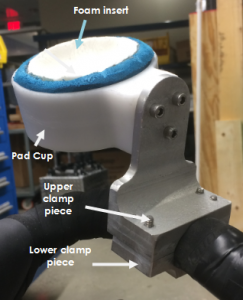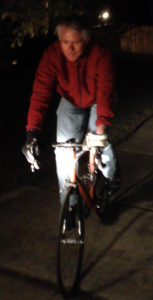Designers: Clarissa Liu, Brendan Smith, Diana Anthony
Client Coordinators: Kimberly Keyser, Russell Mead
Supervising Professor: Larry Bohs
INTRODUCTION
Long distance cycling is essential to the quality of life and health of our client, who does not have a left hand. He currently rides with a pad attached to his handlebars, but this system is unstable and causes shoulder misalignment. The goal of this project is to develop a safe, comfortable, and sturdy pad that allows our client to cycle long distances. The pad will be made of prosthetic foam, and it will be elevated to maintain a balanced shoulder position. The device will be securely attached to the handlebars using metal clamps and will be transferrable between bicycles. The Cycling Pad will allow our client to cycle long distances while avoiding injury due to chronic stress.
SUMMARY OF IMPACT
The cycling pad allows our client to safely ride his bike over distances upwards of 100 miles, taking part in large races and group rides frequently during the summer months. [Our PT] reported that his “shoulder alignment looks much better”, words echoed by our client, “it will take some getting used to, but it feels right”. With the Cycling Pad, our client can ride without such a high risk of developing any chronic stresses in his shoulders or back. According to him, this device is “much better than [his] old system,” and that it “appears to be a keeper.” Riding his bike isn’t just a healthy hobby for him, it’s a lifestyle.
TECHNICAL DESCRIPTION
The Cycling Pad (Figure 1) comprises a two piece custom aluminum clamp, custom Delrin plastic pad cup, and foam pad, and weighs 2.25 lbs. It measures 2.625 inches long, 1.5 inches wide, and 4.25 inches tall when clamped together.
The upper piece of the clamp is shaped like an ‘L’ bracket, with the inner joint radiused to give the connection strength. The stem extends upwards to the pad cup, where three holes are positioned so they align with the holes drilled into the pad cup. On the clamp, they have been rotated 15 degrees off the horizontal lowered towards the client. It is built at the specific height to correct our client’s shoulder misalignment while riding, determined from multiple sessions of client testing. All the edges have been rounded to provide client safety.
The wings of the clamp have the four holes drilled in them to fit 4 10-32 Allen head cap screws. The screws have been counterbored, and the remaining thickness is the length of 2.5 times the diameter of the screw, which is 0.375 inches. The corners in the clamp are 0.125 inch thick.
The pad cup has three holes drilled into its stem, which each have two helicoils inserted in them, which are threaded into the Delrin plastic so that they don’t shift inside the holes. The positioning of the holes is such that the top two holes have a third of the total width of the cup stem between them. The top and bottom holes have a third of the total height between them. This sets them up in an isosceles triangle, distributing the forces felt by the pad cup evenly across the entire stem of the cup.
The foam pad has a lip, which extends over the top of the pad cup edges, so that there are no corners exposed to the client. This adds to the overall comfort and safety of our client while using the device. There are three foams used to make the pad: PVC foam, which is the foam found in yoga blocks for support and shape, a prosthetic memory foam for shock absorption, and a prosthetic thin layer foam for comfort against the skin.
The cost of production of the Cycling Pad with the clamp is $85.16.

